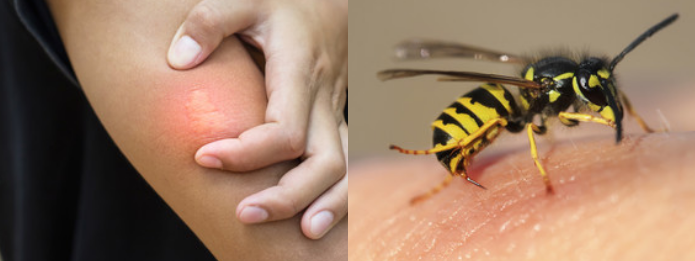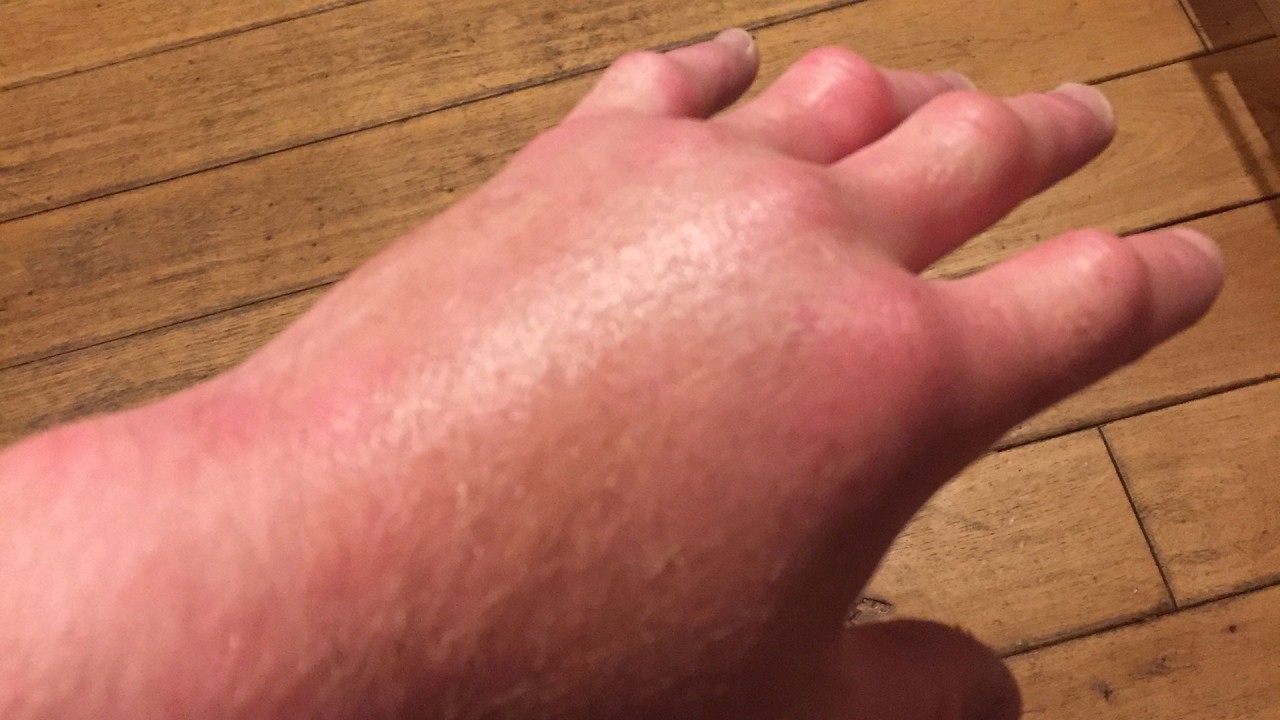
/15611376037_927fff755d_o-56a520293df78cf772865f6b.jpg) https://faculty.ucr.edu/~legneref/entomol/hymenoptera.htm Honeybee (Apis mellifera)
https://faculty.ucr.edu/~legneref/entomol/hymenoptera.htm Honeybee (Apis mellifera)
Description of Hymenopterans; Small hooks, termed hamuli, seam the forewings and the smaller hindwings of these insects collectively.
Both pairs of wings work supportively during flight,
Most Hymenoptera has chewing mouthparts.
Bees are the exclusion, with modified mouthparts and a proboscis for siphoning nectar.
Hymenopteran antennae are set like an elbow or knee, and they have compound eyes.
An ovipositor on the end of the abdomen allows the female to deposit eggs in host plants or insects.Some bees and wasps use a stinger, which is actually a modified ovipositor, to protect them when susceptible.Females progress from fertilized eggs, and males develop from unfertilized eggs.Insects in this order undergo complete metamorphosis. The Hymenoptera are most significant to humans as pollinators of wild and cultivated flowering plants, as parasites of destructive insects, and as makers of honey.The Hymenoptera are remarkable for their great specialization of structure,for their varying degrees of social organization and for the highly developed condition that parasitism has reached.
The Hymenoptera are divided into two suborders:
- Symphyta -mainly sawflies and horntails
- Apocrita -wasps, ants, bees, and most parasitic forms.
Most species, however, are solitary in habit. Hymenopterans might be;
- Parasitic or nonparasitic,
- carnivorous,
- phytophagous, or omnivorous
Habitat and Distribution-Hymenopteran insects live throughout the world, with the exception of Antartica. Like most animals; their distribution is often dependent on their food supply. For example, bees pollinate flowers and require habitats with flowering plants.
Major Families in the Order
- Apidae – honeybees and bumblebees
- Braconidae – parasitic wasps parasites of butterfly and moth larvae
- Cynipidae – gall wasps
- Formicidae – ants
- Scoliidae – scoliid wasps prey on beetle larvae
- Vespidae – hornets and yellow jackets
https://www.britannica.com/animal/hymenopteran/images-videos– For more enquiring about the life of Hymenoptera.
Mechanism of toxicity.
- The venoms of Hymenoptera are composite mixtures of enzymes and are supplied by several means. The venom device is situated in the posterior abdomen of the female.
- The terminal end of the stinger of the Apidae (honeybees) is pointed, so the stinger stays in the prey and more or less of the venom device is torn from the body of the bee, leading in its death as it flies away.
- The musculature surrounding the venom sac carries on to pact for some minutes after evisceration, instigating venom to be expelled obstinately.
- The Bombidae and Vespidae have stingers that stay functionally complete after a sting, resulting in their capacity to impose numerous stings.
- The envenomating Formicidae have secretory venom glands in the posterior abdomen and envenomate either by inserting venom via a stinger or by squirting venom from the posterior,abdomen into a bite wound produced by their mandibles.
SYMPTOMS AND SIGNS
- Most individuals will develop limited local swelling in response to a sting that is of nuisance value.
- A minority of persons will develop excessive local swelling, which could be either instant emerging and climaxing within 1-2 hours and deferred emerging hours subsequently to sting, increasing for 24-48 hours and resolving after three to ten days . Such events only threaten life as in nearness to the airway
- Anaphylaxis is a common and life-threatening result of Hymenoptera stings and is characteristically aa a result of fast systemic release of mast cells and basophil mediators.
- Urticaria, vasodilation,
- Bronchospasm,
- Laryngospasm
- Angioedema are prominent symptoms of the reaction.
- https://www.trulynolen.ca/do-wasps-sting-us-for-no-reason/
- Anaphylactic reactions,
- Cutaneous systemic reactions, and
- Large local reactions
- An anaphylactic reaction includes signs and indications of immunoglobulin E (IgE)-mediated allergy, characteristically affecting more than one organ system. The skin urticaria and angioedema is usually involved, but respiratory or circulatory signs are also projecting. Some of the most severe reactions for instance, unexpected hypotension happen in lack of any skin findings or can be refractory to single or multiple doses of epinephrine.
- A cutaneous systemic reaction or a generalized cutaneous reaction which comprises of signs and indications limited to the skin that is, pruritus, erythema, urticaria, and angioedema, which is usually extensive and include skin that is not contiguous with the sting spot. Reactions involving angioedema of the tongue or throat, which could compromise the airway, are usually omitted from this group and considered anaphylactic reactions.
- Large local reactions are Hymenoptera stings, that are described as skin reactions around the spot of the sting categorized by edema, erythema and itching, with a diameter greater than 10 cm, are much more common than systemic reactions.


Grading system for generalized hypersensitivity reactions

Hymenoptera Treatment
- As mentioned above Hymenoptera stings can result in life-threatening anaphylaxis
- The most severe reactions can be refractory to single or multiple doses of epinephrine.
- Venom immunotherapy (VIT) is highly effective and well-tolerated by most patients.
- VIT for patients with allergies to honey bee, yellow jacket, yellow hornet, white-faced hornet,
- Wasp is given using purified venoms,
- whole body extracts are used in immunotherapy for fire ant allergy.
Inconclusion, at an individual level, reasonable measures comprises minimization of situations that attract the responsible insects for instance garbage, uneaten food for yellow jackets and perfumes for honey bees and use of protective footwear and clothing. Of particular importance is the avoidance of drinking from beverage containers or straws because of the high risk of a sting in the oro-pharynx. At a community level, several of the sting allergy complications have a biological source, such as introduction of the imported fire ant into the USA where natural controls are lacking and decline of native predators (echidnas) of the jack jumper ant and intrusion of housing into the ants’ natural habitat. The rise in anaphylaxis to Ixodes bites on east coast Australia appears to coincide with success of measures to minimise introduced predators of small marsupials, natural hosts for the ticks.
References;
- https://www.britannica.com/animal/hymenopteran
- https://www.thoughtco.com/ants-bees-wasps-order-hymenoptera
- https://www.uptodate.com/contents/hymenoptera-venom-immunotherapy-efficacy-indications-and-mechanism-of-action?topicRef=4095&source=see_link
- Pucci S, D’Alò S, De Pasquale T, Illuminati I, Makri E, Incorvaia C. Risk of anaphylaxis in patients with large local reactions to hymenoptera stings: a retrospective and prospective study. Clin Mol Allergy. 2015;13:21. Published 2015 Nov 9. doi:10.1186/s12948-015-0030-z
- https://www.worldallergy.org/education-and-programs/education/allergic-disease-resource-center/professionals/allergy-to-insect-stings-and-bites